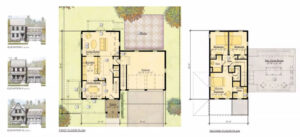
A sketch of what the starter homes might look like (click to enlarge). See the April 27 Lincoln Squirrel article for more project illustrations.
The Planning Board got more details this week on the Nature Link project proposed for Page Road/Route 2 land, including information on sizes and estimated prices of the homes.
The Rural Land Foundation is asking voters at a Special Town Meeting on June 25 to approve rezoning and funding measures that would allow the town to purchase 77 acres of land now owned by the Frank Panetta Jr. Trust and Farrington Memorial. Oriole Landing developer Civico, which is providing $3.3 million of the $6.4 million total land purchase cost, hopes to build 20 tightly clustered single-family condominium homes on some of the parcel, while most of the rest will become town-owned conservation land. Farrington Nature Linc would remain as is, though with a new access road from Page Road.
To make it happen, voters must approve a change to the existing North Lincoln Overlay District for the proposed housing and another to preserve the existing Gerard’s Farm Stand on Route 2, as well as a $950,000 appropriation from the town’s Community Preservation Act fund. Another $800,000 from the City of Cambridge and $1.35 million in private donations to the RLF will round out the total.
The three houses now on the Panetta land will be razed. In addition to 17 small starter homes ranging from 1,650 to 2,000 square feet, the development will include three 4,500-square-foot homes on the southeast corner of the site. Andrew Consigli of Civico estimated that the starter homes will sell for under $1 million while the three larger homes would fetch $1.5 million to $2 million. Three of the starter homes would be income-restricted.
Because it will be a condominium complex, owners will not be allowed to make substantial changes to their homes without consent of the entire condo homeowners’ association. The RLF will have right of first refusal if Farrington Memorial ever decides to sell their parcel, which will have deed restrictions so Farrington Nature Linc can continue to operate on part of the land and “make small additions to their footprint” in the future if desired, said Geoff McGean, Executive Director of the RLF, which is distributing this brochure touting the project.
If all goes as planned, the deal will conserve the largest remaining parcel of undeveloped and unprotected land in Lincoln. “This is the result of many, many years of negotiation,” McGean told the Planning Board. “It’s a balance of benefits, and all parties involved have made some sacrifices. I can’t emphasize enough that this is a moment in time… it’s not going to be there next year.”
The decision to propose small starter homes rather than townhouses or multifamily housing was based on economics as well as the wishes of the Panettas, Consigli said. The development is modeled after the nascent 40Y state program, though the Lincoln proposal would allow houses larger than the $1,850-square-foot state maximum.
The Planning Board will hold a public hearing on June 10. Before that will be public information sessions and site walks as well as presentations to the Conservation Commission, Community Preservation Committee, and Housing Coalition.
Each house will have a two-car garage and a small private yard, and residents will have access to a common green. “It’s going to have a very communal feel,” said Jeremy Lake of Union Studio Architecture & Community Design, which designed the Riverwalk housing in West Concord.
Planning Board member Susan Hall Mygatt was concerned that preserving the commercial farm stand alongside the housing might constitute spot zoning. Director of Planning and Land Use Paula Vaughn-Mackenzie said town counsel was reviewing the issue.
Many attendees at the April 29 meeting expressed support for the proposal. Andrew Glass, chair of the Historical Commission, noted that his group approves about half a dozen teardowns each year, and most of them are small houses. “This will help replenish a form of housing stock in Lincoln that we have seen a great decimation of in the last several decades,” he said.
Leave a Reply